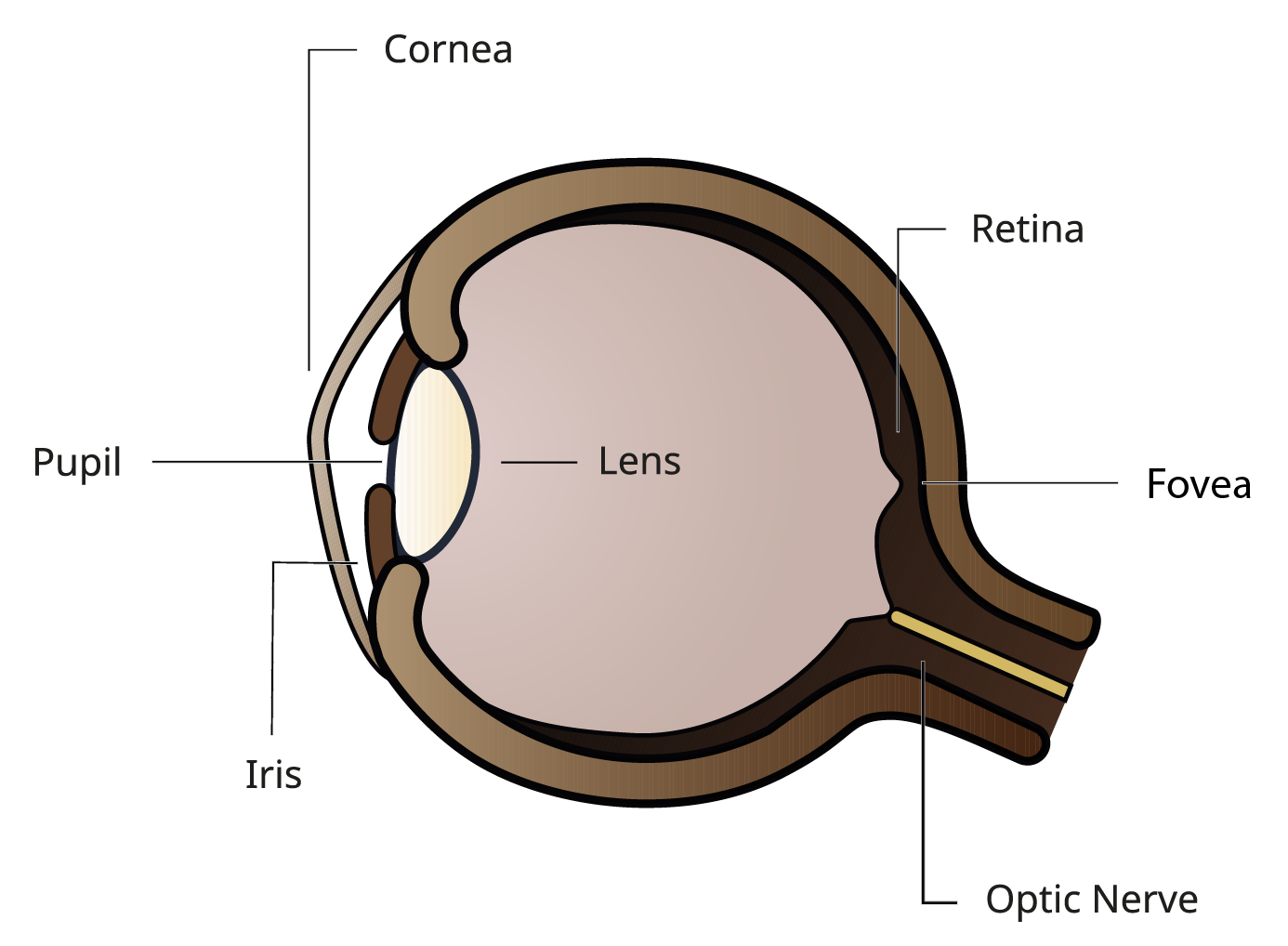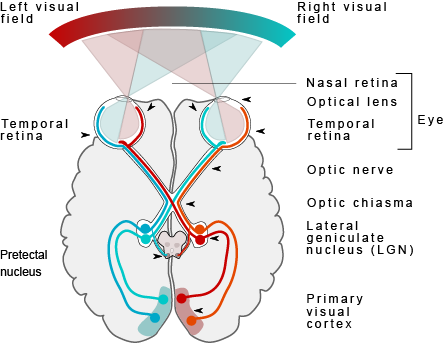Chapter 5. Sensation and Perception
Vision
Jessica Motherwell McFarlane
Approximate reading time: 12 minutes
The visual system constructs a mental representation of the world around us (Figure SP.8). This contributes to our ability to successfully navigate through physical space and interact with important individuals and objects in our environments. This section will provide an overview of the basic anatomy and function of the visual system. In addition, we will explore our ability to perceive colour and depth.

Anatomy of the Visual System
The eye is the major sensory organ involved in vision (Figure SP.9). Light waves are transmitted across the cornea and enter the eye through the pupil. The cornea is the transparent covering over the eye. It serves as a barrier between the inner eye and the outside world, and is involved in focusing light waves that enter the eye. The pupil is the small opening in the eye through which light passes, and the size of the pupil can change as a function of light levels as well as emotional arousal. When light levels are low, the pupil will become dilated, or expanded, to allow more light to enter the eye. When light levels are high, the pupil will constrict, or become smaller, to reduce the amount of light that enters the eye. The pupil’s size is controlled by muscles that are connected to the iris, which is the coloured portion of the eye.

After passing through the pupil, light crosses the lens, a curved, transparent structure that serves to provide additional focus. The lens is attached to muscles that can change its shape to aid in focusing light that is reflected from near or far objects. As our gaze shifts from near to distant objects, accommodation occurs. Accommodation refers to the process of changing the curvature of the lens to keep light entering the eye focused on the retina. In a normal-sighted individual, the lens will focus images perfectly on a small indentation in the back of the eye known as the fovea, which is part of the retina, the light-sensitive lining of the eye. The fovea contains densely packed specialised photoreceptor cells (Figure SAP.14). These photoreceptor cells, known as cones, are light-detecting cells. The cones are specialised types of photoreceptors that work best in bright light conditions. Cones are very sensitive to acute detail and provide tremendous spatial resolution. They also are directly involved in our ability to perceive colour.
While cones are concentrated in the fovea, where images tend to be focused, rods, another type of photoreceptor, are located throughout the remainder of the retina. Rods are specialised photoreceptors that work well in low light conditions, and while they lack the spatial resolution and colour function of the cones, they are involved in our vision in dimly lit environments as well as in our perception of movement on the periphery of our visual field.

We have all experienced the different sensitivities of rods and cones when making the transition from a brightly lit environment to a dimly lit environment. Imagine going to see a movie on a clear summer day. As you walk from the brightly lit lobby into the dark theatre, you notice that you immediately have difficulty seeing much of anything. After a few minutes, you begin to adjust to the darkness and can see the interior of the theatre. In the bright environment, your vision was dominated primarily by cone activity. As you move to the dark environment, rod activity dominates, but there is a delay in transitioning between the phases. If your rods do not transform light into nerve impulses as easily and efficiently as they should, you will have difficulty seeing in dim light, a condition known as night blindness.
Rods and cones are connected (via several interneurons) to retinal ganglion cells. Axons from the retinal ganglion cells converge and exit through the back of the eye to form the optic nerve. The optic nerve carries visual information from the retina to the brain. There is a point in the visual field called the blind spot: Even when light from a small object is focused on the blind spot, we do not see it. We are not consciously aware of our blind spots for two reasons: First, each eye gets a slightly different view of the visual field; therefore, the blind spots do not overlap. Second, our visual system fills in the blind spot so that although we cannot respond to visual information that occurs in that portion of the visual field, we are also not aware that information is missing.

The optic nerve from each eye merges just below the brain at a point called the optic chiasm. As Figure SP.11 shows, the optic chiasm is an X-shaped structure that sits just below the cerebral cortex at the front of the brain. At the point of the optic chiasm, information from the right visual field (which comes from both eyes) is sent to the left side of the brain, and information from the left visual field is sent to the right side of the brain.
Once inside the brain, visual information is sent via a number of structures, such as the lateral geniculate nucleus (LGN), to the occipital lobe at the back of the brain for processing. The LGN is a cluster of neuron cell bodies located in the thalamus. Visual information might be processed in parallel pathways which can generally be described as the “what pathway” and the “where/how” pathway. The “what pathway” (ventral stream) is involved in object recognition and identification, while the “where/how pathway” (dorsal stream) is involved with location in space and how one might interact with a particular visual stimulus (Milner & Goodale, 2008; Ungerleider & Haxby, 1994). For example, when you see a ball rolling down the street, the “what pathway” identifies what the object is, and the “where/how pathway” identifies its location or movement in space.
Usually, if we have healthy vision, we do not see the world in black and white; neither do we see it as two-dimensional (2D) or flat (just height and width, no depth). Read Supplement SP.6: Deep Dive – Colour Vision and Depth Perception to learn how colour vision works and how we perceive three dimensions (height, width, and depth).
Watch this video: Tricky Topics: Visual Pathway (3.5 minutes)
“Tricky Topics: Visual Pathway” video by FirstYearPsych Dalhousie is licensed under the Standard YouTube licence.
Blindsight
“Blindsight” happens when part of the brain that processes vision is damaged. People with blindsight can’t consciously see things, but they can still answer questions about what’s around them, like where something is or if it’s moving (Weiskrantz, 1997). It’s like their brain knows what’s there, even if they don’t consciously realise it.
Image Attributions
Figure SP.8. Figure 5.10 credit “top left”: Image by ha11ok from Pixabay; credit “top right”: Image by Vitor Vitinho from Pixabay; credit “middle left”: Image by lisa runnels from Pixabay,; credit “middle right”:Image by iris Vallejo from Pixabay; credit “bottom left”: Image by Kenny Elijah from Pixabay; credit “bottom right”: Image by bess.hamiti@gmail.com from Pixabay, all licensed under the Pixabay Content License.
Figure SP.9. Human eye by Rachel Lu is licensed under a CC BY-NC-SA license.
Figure SP.10. Figure SAP.14 created by Molly Wells Art as found in Introduction to Psychology & Neuroscience (2nd Edition) is licensed under a CC BY 4.0 License.
Figure SP.11. A simplified schema of the human visual pathway By Miquel Perello Nieto is licensed under a CC BY-SA 4.0 license.
To calculate this time, we used a reading speed of 150 words per minute and then added extra time to account for images and videos. This is just to give you a rough idea of the length of the chapter section. How long it will take you to engage with this chapter will vary greatly depending on all sorts of things (the complexity of the content, your ability to focus, etc).

